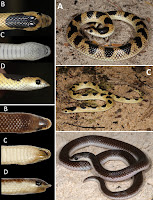 |
| Prosymna lisima Conradie, Keates, Baptista & Lobón-Rovira, 2022 |
Abstract
African Shovel-snout snakes (Prosymna Gray, 1849) are small, semi-fossorial snakes with a unique compressed and beak-like snout. Prosymna occur mainly in the savanna of sub-Saharan Africa. Of the 16 currently recognised species, four occur in Angola: Prosymna ambigua Bocage, 1873, P. angolensis Boulenger, 1915, P. frontalis (Peters, 1867), and P. visseri FitzSimons, 1959. The taxonomical status and evolutionary relationships of P. angolensis have never been assessed due to the lack of genetic material. This species is known to occur from western Angola southwards to Namibia, and eastwards to Zambia, Botswana and Zimbabwe. The species shows considerable variation in dorsal colouration across its range, and with the lower ventral scales count, an ‘eastern race’ was suggested. In recent years, Prosymna material from different parts of Angola has been collected, and with phylogenetic analysis and High Resolution X-ray Computed Tomography, the taxonomic status of these populations can be reviewed. Strong phylogenetic evidence was found to include the angolensis subgroup as part of the larger sundevalli group, and the existence of three phylogenetic lineages within the angolensis subgroup were identified, which each exhibit clear morphological and colouration differences. One of these lineages is assigned to the nominotypical P. angolensis and the other two described as new species, one of which corroborates the distinct eastern population previously detected. These results reinforce that a considerable part of Angolan herpetological diversity is still to be described and the need for further studies.
Keywords: Africa, Angola, cryptic species, fossorial, Kalahari, Serpentes
Reptilia
Squamata
Prosymnidae
 |
| Holotype of Prosymna lisima sp. nov. (PEM R23512) from Cuito River source, Moxico Province, Angola A dorsal and ventral full body B dorsal head C ventral head D lateral head. |
Prosymna lisima sp. nov.
Common names: Kalahari Shovel-snout snake (English);
Cobra-de-focinho-de-pá-do-kalahari (Portuguese).
Etymology: The name lisima is derived from the locally spoken Luchaze language in the region of the type locality meaning ‘source’. The full phrase used, ‘Lisima Lwa Mwondo’, is translated as “source of life”. This is a reference to central Angola, a high rainfall area where some of the most important rivers in Angola arise. This water makes it its way to the Okavango Delta, sustaining wildlife and local communities in Angola, Namibia and Botswana.
 |
| Live Prosymna confusa sp. nov. (PEM R24013) from 20 km west of Lola on the road northwest to Camacuio and on the edge of Bentiaba River, Namibe Province, Angola (Photo: Bill Branch). |
Prosymna confusa sp. nov.
Common names: Plain Shovel-snout Snake (English);
Cobra-de-focinho-de-pá-lisa (Portuguese).
Etymology: When the late Bill Branch collected the holotype, he was unsure of its identification and referred to it as an unusual specimen that could not be assigned to any known species from Angola. He later referred to it as P. ambigua (Branch 2018), presumably based on its uniform grey colouration. The name confusa is a reflection of the confusion this specimen has caused and of the general confusion in the P. angolensis group.
Werner Conradie, Chad Keates, Ninda L. Baptista and Javier Lobón-Rovira. 2022. Taxonomical Review of Prosymna angolensis Boulenger, 1915 (Elapoidea, Prosymnidae) with the Description of Two New Species. ZooKeys. 1121: 97-143. DOI: doi.org/10.3897/zookeys.1121.85693
Resumo: As cobras-de-focinho-de-pá africanas (Prosymna) são pequenas cobras semi-fossoriais com um focinho único, achatado e em forma de bico, que ocorrem principalmente na savana da África subsaariana. Das 16 espécies actualmente reconhecidas, quatro existem em Angola: Prosymna ambigua Bocage, 1873, P. angolensis Boulenger, 1915, P. frontalis (Peters, 1867), e P. visseri Fitz-Simons, 1959. O estatuto taxonómico e as relações evolutivas de P. angolensis nunca foram avaliados devido à falta de material genético. A espécie ocorre desde o oeste de Angola, para sul até a Namíbia, e para este em direcção à Zâmbia, Botswana e Zimbábue. Na sua área de ocorrência, esta espécie tem variação principalmente na coloração dorsal, e com base no menor número de escamas ventrais, foi sugerida a existência de uma raça oriental. Recentemente foi amostrado material de Prosymna de várias partes de Angola, e com recurso a análises filogenéticas e a tomografia computadorizada de raios-X de alta resolução, foi possível rever o estatuto taxonómico destas populações. Encontrámos fortes evidências filogenéticas para incluir o subgrupo angolensis como parte do grupo sundevalli. Revelámos a existência de três linhagens filogenéticas no subgrupo angolensis. Atribuímos uma dessas linhagens ao P. angolensis nominotípico, e descrevemos as outras duas como espécies novas, uma das quais corrobora a população oriental previamente detectada. Estes resultados reforçam a ideia de que uma parte considerável da diversidade herpetológica angolana está ainda por descrever, e a necessidade de mais estudos.
Palavras-chave: África, Angola, espécies crípticas, fossorial, Kalahari, Serpentes



